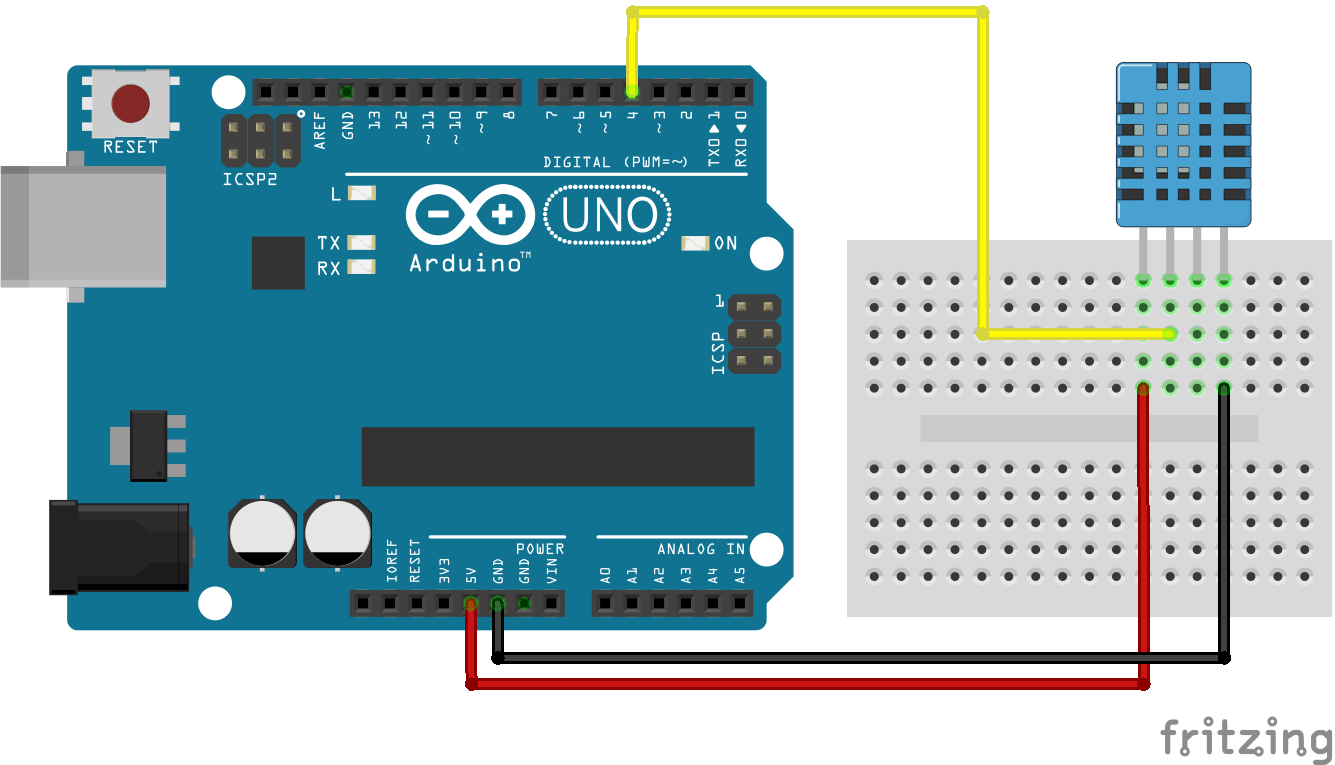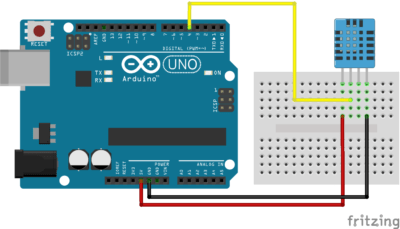El sensor DHT11 puede medir la temperatura y la humedad en una habitación. Aquí hay un tutorial sobre cómo recuperar la medición del sensor con una Arduino.
Material
- Computadora
- Arduino UNO
- USB cable
- sensor DHT11
- Cables de puente M/M
- tablero de circuitos
Diagrama de conexión

Código
El programa para leer la medición del sensor DHT11 es bastante complejo y requiere un poco de trabajo. En tal caso, la forma más fácil es usar una biblioteca desarrollada por Arduino u otros usuarios. Esas bibliotecas pueden provenir de muchas fuentes: Arduino, por supuesto, pero también GitHub que es una referencia en el intercambio de códigos. En nuestro caso, copiamos el código de Arduino.
Crear carpeta de biblioteca
Las bibliotecas a menudo están disponibles como archivos ZIP descargables que deben extraerse en la carpeta de la biblioteca IDE (generalmente. \ Documents \ Arduino \ bibliotecas). Para usar el código sin formato copiado de una fuente aleatoria, necesitamos crear manualmente los archivos .h y .cpp, en una carpeta DHT11lib, en la que copiaremos y pegaremos el código del sitio web.

dht11.h
// // FILE: dht11.h // VERSION: 0.4.1 // PURPOSE: DHT11 Temperature & Humidity Sensor library for Arduino // LICENSE: GPL v3 (https://www.gnu.org/licenses/gpl.html) // // DATASHEET: https://www.micro4you.com/files/sensor/DHT11.pdf // // URL: https://playground.arduino.cc/Main/DHT11Lib // // HISTORY: // George Hadjikyriacou - Original version // see dht.cpp file // #ifndef dht11_h #define dht11_h #if defined(ARDUINO) && (ARDUINO >= 100) #include <Arduino.h> #else #include <WProgram.h> #endif #define DHT11LIB_VERSION "0.4.1" #define DHTLIB_OK 0 #define DHTLIB_ERROR_CHECKSUM -1 #define DHTLIB_ERROR_TIMEOUT -2 class dht11 { public: int read(int pin); int humidity; int temperature; }; #endif // // END OF FILE //
dht11.cpp
// // FILE: dht11.cpp // VERSION: 0.4.1 // PURPOSE: DHT11 Temperature & Humidity Sensor library for Arduino // LICENSE: GPL v3 (https://www.gnu.org/licenses/gpl.html) // // DATASHEET: https://www.micro4you.com/files/sensor/DHT11.pdf // // HISTORY: // George Hadjikyriacou - Original version (??) // Mod by SimKard - Version 0.2 (24/11/2010) // Mod by Rob Tillaart - Version 0.3 (28/03/2011) // + added comments // + removed all non DHT11 specific code // + added references // Mod by Rob Tillaart - Version 0.4 (17/03/2012) // + added 1.0 support // Mod by Rob Tillaart - Version 0.4.1 (19/05/2012) // + added error codes // #include "dht11.h" // Return values: // DHTLIB_OK // DHTLIB_ERROR_CHECKSUM // DHTLIB_ERROR_TIMEOUT int dht11::read(int pin) { // BUFFER TO RECEIVE uint8_t bits[5]; uint8_t cnt = 7; uint8_t idx = 0; // EMPTY BUFFER for (int i=0; i< 5; i++) bits[i] = 0; // REQUEST SAMPLE pinMode(pin, OUTPUT); digitalWrite(pin, LOW); delay(18); digitalWrite(pin, HIGH); delayMicroseconds(40); pinMode(pin, INPUT); // ACKNOWLEDGE or TIMEOUT unsigned int loopCnt = 10000; while(digitalRead(pin) == LOW) if (loopCnt-- == 0) return DHTLIB_ERROR_TIMEOUT; loopCnt = 10000; while(digitalRead(pin) == HIGH) if (loopCnt-- == 0) return DHTLIB_ERROR_TIMEOUT; // READ OUTPUT - 40 BITS => 5 BYTES or TIMEOUT for (int i=0; i<40; i++) { loopCnt = 10000; while(digitalRead(pin) == LOW) if (loopCnt-- == 0) return DHTLIB_ERROR_TIMEOUT; unsigned long t = micros(); loopCnt = 10000; while(digitalRead(pin) == HIGH) if (loopCnt-- == 0) return DHTLIB_ERROR_TIMEOUT; if ((micros() - t) > 40) bits[idx] |= (1 << cnt); if (cnt == 0) // next byte? { cnt = 7; // restart at MSB idx++; // next byte! } else cnt--; } // WRITE TO RIGHT VARS // as bits[1] and bits[3] are always zero they are omitted in formulas. humidity = bits[0]; temperature = bits[2]; uint8_t sum = bits[0] + bits[2]; if (bits[4] != sum) return DHTLIB_ERROR_CHECKSUM; return DHTLIB_OK; } // // END OF FILE //
Uso de la biblioteca.
Una vez que la biblioteca se creó y se presentó en el IDE, podemos crear el archivo .ino en el que usamos la biblioteca. Adaptamos ligeramente el ejemplo del sitio web para adaptarlo a nuestro caso.
#include <dht11.h> dht11 DHT11; #define DHT11PIN 4 void setup() { Serial.begin(9600); Serial.println("DHT11 TEST PROGRAM "); Serial.print("LIBRARY VERSION: "); Serial.println(DHT11LIB_VERSION); Serial.println(); } void loop() { Serial.println("\n"); int chk = DHT11.read(DHT11PIN); Serial.print("Read sensor: "); switch (chk) { case DHTLIB_OK: Serial.println("OK"); Serial.print("Humidity (%): "); Serial.println((float)DHT11.humidity, 2); Serial.print("Temperature (°C): "); Serial.println((float)DHT11.temperature, 2); Serial.print("Temperature (°F): "); Serial.println(Fahrenheit(DHT11.temperature), 2); Serial.print("Temperature (°K): "); Serial.println(Kelvin(DHT11.temperature), 2); Serial.print("Dew PointFast (°C): "); Serial.println(dewPointFast(DHT11.temperature, DHT11.humidity)); break; case DHTLIB_ERROR_CHECKSUM: Serial.println("Checksum error"); break; case DHTLIB_ERROR_TIMEOUT: Serial.println("Time out error"); break; default: Serial.println("Unknown error"); break; } delay(2000); } //Celsius to Fahrenheit conversion double Fahrenheit(double celsius) { return 1.8 * celsius + 32; } //Celsius to Kelvin conversion double Kelvin(double celsius) { return celsius + 273.15; } // dewPoint function NOAA // reference (1) : http://wahiduddin.net/calc/density_algorithms.htm // reference (2) : http://www.colorado.edu/geography/weather_station/Geog_site/about.htm double dewPointFast(double celsius, double humidity) { double a = 17.271; double b = 237.7; double temp = (a * celsius) / (b + celsius) + log(humidity*0.01); double Td = (b * temp) / (a - temp); return Td; }
N.B.: cuando copie el código de un sitio web, compruebe siempre si la versión y el cableado de sus componentes son los mismos para evitar problemas de compatibilidad.
N.B.: existe otra versión de DHT11. Si tiene una de esas otras versiones, consulte la biblioteca DHTLib.
Solicitud
- Cree una estación meteo con un sensor DHT11 y una pantalla LCD
Sources
Encuentre otros tutoriales y ejemplos en el generador de código automático
Arquitecto de Código




